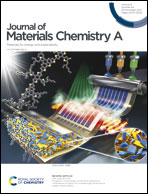Supporting a Cu@In2O3 core–shell structure on N-doped graphitic carbon cuboctahedral cages for efficient photocatalytic homo-coupling of terminal alkynes†
Abstract
Improving the separation efficiency of photogenerated carriers and exposing more active sites are two important factors to improve the photocatalytic efficiency of photocatalysts. Designing appropriate materials with special structure and composition to achieve the above-mentioned objectives is the focus and hotspot of scientists' research. In this study, N-doped graphitic-carbon (NGC) cuboctahedral cage-supported core–shell Cu@In2O3 nanocomposites (denoted as Cu/In2O3@N–C) was prepared via the calcination of In-loaded HKUST-1 cuboctahedral nanoparticles. Using air(O2) as an oxidant, initiated by visible-light under ambient conditions, eco-friendly Cu/In2O3@N–C shows high efficiency, good recyclability, and excellent functional-group tolerability on the photocatalyzing home-coupling of terminal alkynes. Its highly enhanced photocatalytic performances are ascribed to its unique structural features. Precisely integrating the photoredox function of semiconductive In2O3, conductivity of Cu and NGC promotes rich generation and effective transfer-separation of photo-induced carriers. Intrinsically, the photocatalytic activity of Cu on the home-coupling of terminal alkynes and enhanced adsorptivity of phenylacetylene by the Cu/In2O3 heterostructure, which has been proved by DFT calculations, further boost photocatalytic efficiency. Simultaneously, hollow cuboctahedral cages provide abundant photoactive sites.



 Please wait while we load your content...
Please wait while we load your content...